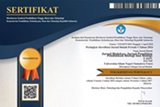The superiority of Zymomonas mobilis in producing bioethanol from Coffea arabica peel using cellulolytic enzyme treatment
Abstract
Keywords
Full Text:
PDFReferences
Argo, B. D., Wardani, A. K., Zubaidah, E., & Winarsih, S. (2014). The increasement of rice straw hydrolysis using blend crude cellulose enzyme from Trichoderma reesei and Aspergillus niger. Research & Reviews in BioSciences, 9(2), 41–44.
Azizah, N., Al-Baari, A., & Mulyani, S. (2012). Pengaruh Lama Fermentasi Terhadap Kadar Alkohol, pH, dan Produksi Gas pada Proses Fermentasi Bioetanol dari Whey dengan Substitusi Kulit Nanas. Jurnal Aplikasi Teknologi Pangan, 1(2), 72–77. https://doi.org/10.17728/JATP.V1I3.73
Bilyartinus, G., & Siswanto, A. P. (2021). The Effect of Bacillus subtilis on Bioethanol Production from Ambon Banana (Musa paradisiaca var. sapientum Linn) Peels by Using Fermentation Process. Journal of Vocational Studies on Applied Research, 3(2), 26–30. https://doi.org/10.14710/jvsar.v3i2.11081
Corro, G., Pal, U., Bañuelos, F., & Rosas, M. (2013). Generation of biogas from coffee-pulp and cow-dung co-digestion: Infrared studies of postcombustion emissions. Energy Conversion and Management, 74, 471–481. https://doi.org/10.1016/j.enconman.2013.07.017
Febriana. (2020). Pengaruh Variasi Massa Ragi Saccharomyces cerevisiae dan Waktu Fermentasi Terhadap Kadar Bioetanol Berbahan Dasar Limbah Kulit Kopi Arabika (Coffea arabica L.). AMINA, 2(1), 19–25.
Gielen, D., Boshell, F., Saygin, D., Bazilian, M. D., Wagner, N., & Gorini, R. (2019). The role of renewable energy in the global energy transformation. Energy Strategy Reviews, 24, 38–50. https://doi.org/10.1016/j.esr.2019.01.006
He, M. X., Wu, B., Qin, H., Ruan, Z. Y., Tan, F. R., Wang, J. L., Shui, Z. X., Dai, L. C., Zhu, Q. L., Pan, K., Tang, X. Y., Wang, W. G., & Hu, Q. C. (2014). Zymomonas mobilis: A novel platform for future biorefineries. Biotechnology for Biofuels, 7(101), 1-15. https://doi.org/10.1186/1754-6834-7-101
Hendrasarie, N., & Mahendra, D. E. (2020). Pemanfaatan Sampah Sayur Dari Pasar Tradisional Untuk Produksi Bioetanol. Jurnal Serambi Engineering, 5(3), 1115–1122. https://doi.org/10.32672/jse.v5i3.2075
Irvan, Putri, A. W., Surbakti, S. U., & Trisakti, B. (2016). Pengaruh Konsentrasi Ragi Dan Waktu Fermentasi Pada Pembuatan Bioetanol Dari Biji Cempedak (Artocarpus champeden spreng). Jurnal Teknik Kimia Usu, 5(2), 21–26.
Jackson, B., & Jayanthy, T. (2014). Determination of sucrose in raw sugarcane juice by microwave method. Indian Journal of Science and Technology, 7(5), 566–570.
Jennifer, V., & Thiruneelakandan, G. (2015). Enzymatic Activity of Marine Lactobacillus Species from South East Coast of India. Ijiset, 2(1), 542–546.
Johnsson, F., Kjärstad, J., & Rootzén, J. (2019). The threat to climate change mitigation posed by the abundance of fossil fuels. Climate Policy, 19(2), 258-274. https://doi.org/10.1080/14693062.2018.1483885
Kusumaningati, M. A., Nurhatika, S., & Muhibuddin, A. (2013). Pengaruh Konsentrasi Inokulum Bakteri Zymomonas mobilis dan Lama Fermentasi Pada Produksi Etanol dari Sampah Sayur dan Buah Pasar Wonokromo Surabaya. Jurnal Sains Dan Seni ITS, 2(2), E218–E223.
Minister of Energy and Mineral Resources of the Republic of Indonesia. (2021). Handbook of Energy & Economy Statistics of Indonesia 2020.
Mulyasari, M., Melati, I., & Sunarno, M. T. D. (2015). Isolasi, Seleksi, dan identifikasi Bakteri Selulolitik dari Rumput Laut Turbinaria sp. dan Sargassum sp. sebagai Kandidat Pendegradasi Serat Kasar Pakan Ikan. Jurnal Riset Akuakultur, 10(1), 51. 258-274
Nababan, M., Gunam, I. B. W., & Mahaputra Wijaya, I. M. (2019). Produksi Enzim Selulase Kasar Dari Bakteri Selulolitik. Jurnal Rekayasa Dan Manajemen Agroindustri, 7(2), 190. https://doi.org/10.24843/jrma.2019.v07.i02.p03
Paloboran, M. E. N., Nyoman Sutantra, I., & Sudarmanta, B. (2016). Performances and emissions characteristics of three main types composition of gasoline-ethanol blended in spark ignition engines. International Review of Mechanical Engineering, 10(7), 552–559. https://doi.org/10.15866/ireme.v10i7.9968
Rahmadani, S., Muria, S. R., & Utami, S. P. (2017). Produksi Bioetanol Dari Mahkota Nanas Menggunakan Bakteri Zymomonas mobilis Dengan Variasi Konsentrasi Inokulum Dan Penambahan Nutrisi. Fteknik, 4(2), 1639–1642.
Rahmawati. (2010). Utilization of Cassava Skin Waste (Manihot utilissima Pohl.) And Pineapple Skin (Ananas comosus L.) on Bioethanol Production Using Aspergillus niger. Journal of Food Technology Application Research, 2(2), 73–75.
Reddy, V., Lakshmi, V., Reddy, V. K., Bindu, H., & Narasu, M. L. (2016). Isolation, Screening, Identification and Optimized Production of Extracellular Cellulase from Bacillus subtilis using Cellulosic Waste ad Carbon Source. Journal of Microbiology, Biotechnology and Food Sciences, 2(6), 2383–2386.
Safaria, Indiawati, N., & Zaharah, T. A. (2013). Efektivitas Campuran Enzim Selulase dari Aspergillus niger dan Trichoderma reseei dalam Menghidrolisis Substrat Sabut Kelapa. Jurnal Jkk, 2(1), 1–19.
Said, N. N. A., & Purnama, H. (2020). Pembuatan Bioetanol dari Limbah Kulit Kopi Arabika dan Robusta dengan Variasi Waktu Fermentasi. Proceeding of The URECOL, 220–228.
Sandika, A. S., Muria, S. R., & Yenti, S. R. (2017). Fermentasi Kulit Nanas menjadi Bioetanol Menggunakan Zymomonas mobilis dengan Variasi Pemekataan Medium dan Waktu Fermentasi. Jom Fteknik, 4(1), 1-5.
Saragih, H. T. M., Sembiring, J. H., & Ginting, E. (2023). Conversion Of Pineapple Peel Glucose Into Bioethanol Using Simultaneous Saccharification And Fermentation (Ssf) Method And Separate Hydrolysis And Fermentation (SHF) Method. Jurnal Kimia Riset, 8(2), 167 – 174.
Susilo, B., Damayanti, R., & Izza, N. (2017). Teknik Bioenergi. Tim UB Press.
Widyaningrum, T., & Parahadi, M. (2020). Bioethanol Levels of Dragon Fruit (Hylocereus polyrhizus) Peel with the Addition of Blend Crude Cellulase Enzyme from Trichoderma reesei and Aspergillus niger. Journal of Tropica; Biodiversity and Biotechnology, 5(1), 1–5. https://doi.org/10.22146/jtbb.52189
Wiratno, E. N., Ardyati, T., & Wardani, A. K. (2014). Effect of Reducing Sugar and Total Nitrogen to Ethanol Production from Molasses by Saccharomyces cerevisiae. The Journal of Experimental Life Sciences, 4(2), 50–55. https://doi.org/10.21776/ub.jels.2014.004.02.05
Zhang, K. & Feng, H. (2010). Fermentation Potantials of Zymomonas mobilis and Its Application in Ethanol Production From Low-Cost Raw Sweet Potato. African Journal of Biotechnology, 9(37), 6122–6128.
DOI: http://dx.doi.org/10.30821/biolokus.v8i1.4482
Refbacks
- There are currently no refbacks.
Copyright (c) 2025 Jurnal Biolokus : Jurnal Penelitian Pendidikan Biologi dan Biologi
indexed by :












